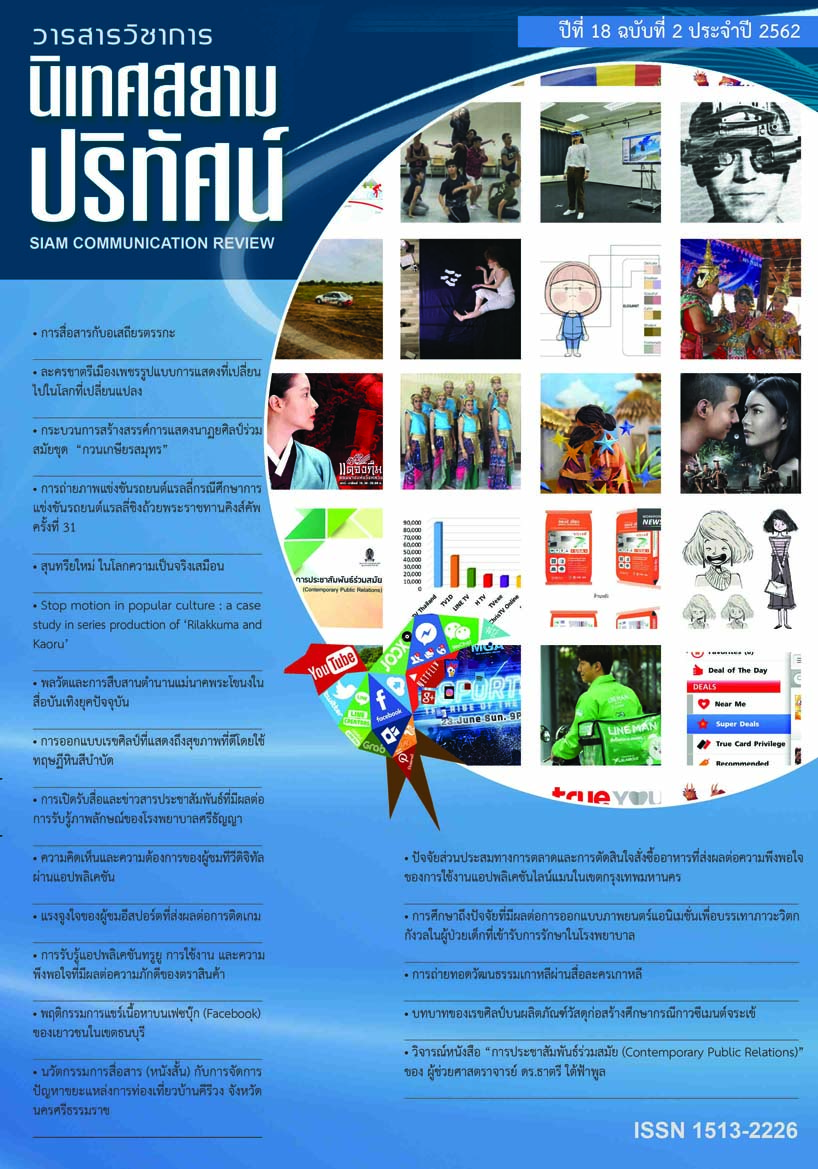The Study of Factors Influencing Animation to Relieve Anxiety of Pediatric Inpatients with Cancer
Main Article Content
Abstract
Mental illness is often found in child patients, who admitted at the hospital for a long time especially with those children who were diagnosed cancer, due to the complexity of medical treatment and the unknown of what they have to confront during their time in the hospital. Normally, children have to be faced with the antipathy and their technique to meet those states is the Fantasy Play. Children will imagine they have power and able to fight with the hostility. Therefore, this study is to focus on finding the way to design an animation through child patients’ anxiety. As first, child patients’ anxiety and proper types of fantasy were studied. Three Child Development Psychiatrists found most factors affecting anxiety in child patients are being separated from people their love, familiarity, the fear of pain and operations. Usually child patients are shy and maladjustment which a suitable type of fantasy is Visual Fantasy. The result of study will be used to design the characters and scenes in animation which the main character is a bashful and inadaptable child who got cancer, a monster is referred to the pain from treatment and scene in a fantasy world would be represented as children’s anxiety. From there, 5 Animation Specialists analyzed those characters, from the variable mentioned above, found that the suitable key words to design a child patient character are Youthful, Casual, Friendly, Generous, Reflective and Elegant, the suitable key words to design a monster are Large gesture, Addictions, Dynamic and Modern and proper key words to design the fantasy world are Classic, Dandy, Dynamic and Modern.
Article Details
References
กนกจันทร์ เขม้นการ. (2554). ความรู้สึกของเด็กเมื่อเข้ารับการรักษาในโรงพยาบาล: การจัดการทางการพยาบาล. วารสารพยาบาลศาสตร์และสุขภาพ, 34(3), 76-78.
นารีรัตน์ อมรศุภรศาสตร์. ผลของการให้ข้อมูลแบบรูปธรรม-ปรนัยผ่านการ์ตูนแอนิเมชั่นต่อความวิตกกังวลของเด็กวัยเรียนที่เข้ารับการตรวจสวนหัวใจ. วิทยานิพนธ์ปริญญามหาบัณฑิต สาขาการพยาบาลเด็ก คณะพยาบาลศาสตร์ มหาวิทยาลัยมหิดล, 2553.
รสสุคนธ์ อยู่เย็น. (2557) ผลของการจดักจิกรรมการเล่านิทานประกอบการแสดงบทบาทสมมติที่มีต่อ ความเชื่อมั่นในตนเองของเด็กชั้นอนุบาลปีที่ 2. วารสารวิชาการ Veridian E-Journal, Humanities, Social Sciences and arts Silpakorn University.7(2), 779-787
ภาษาอังกฤษ
COYNE, I. (2006). Children’s experiences of hospitalization. Journal of Child Health Care, 10(4), 326-336. doi:10.1177/1367493506067884
James, E. (2012). The development of children's fantasy. In The Cambridge companion to fantasy literature (First ed., pp. 50-61). Cambridge: Cambridge University Press.
Johnson, M. R., Whitt, J. K., & Martin, B. (1987). The Effect of Fantasy Facilitation of Anxiety in Chronically Ill and Healthy Children. Journal of Pediatric Psychology, 12(2), 273-284. doi:10.1093/jpepsy/12.2.273
Patcharapa Kanchanaudom and Nattha Wattanaviroj. (2016). Fatigue assessment in children with cancer. Veridian E-Journal, Science and Technology Silpakorn University. 3(6), 138-148
ระบบออนไลน์
จิรัญญา พานิชย์, วราภรณ์ ชัยวัฒน์ (2550, กรกฎาคม). ประสบการณ์การเจ็บป่วยของผู้ป่วยเกวัยเรียนโรคมะเร็งเม็ดเลือดขาว. วารสารสภาการพยาบาล, 22(3), 40-54. เข้าถึงได้จาก http://digi.library.tu.ac.th/journal/0192/22_3_jul_sep_2550/05PAGE40_PAGE54.pdf
จันท์ฑิตา พฤกษานานนท์ (2556). โลกแห่งจินตนาการของเด็ก, คลินิกเด็กดอทคอม, เข้าถึงได้จาก http://www.clinicdek.com/?p=120, เข้าถึงเมื่อ 24 ตุลาคม 2558.
อุทัยวรรณ พุทธรัตน์, ลักขณา คงแสง, จารีย์ พรมบุตร และ บุษกร พันธ์เมธาฤทธิ์. (2556, มกราคม). พฤติกรรมการปรับตัวของเด็กต่อสถานที่ใหม่ของฝ่าย พัฒนาเด็กปฐมวัย. วารสารพยาบาลสงขลานครินทร์, 1, 1-16. เข้าถึงได้จาก http://www.nur.psu.ac.th/WebPak/filenew/การพยาบาลกุมารเวชศาสตร์401บทความ อ.อุทัยวรรณ 56.pdf
Kasinathan, I. D. (2013, December). Easing children's anxiety during wound care. Retrieved September 26, 2016,fromhttps://www.kkh.com.sg/AboutUs/Publications/Documents/ Easing children's anxiety during wound care_SD Sep-Oct13_V61_I5.pdf


